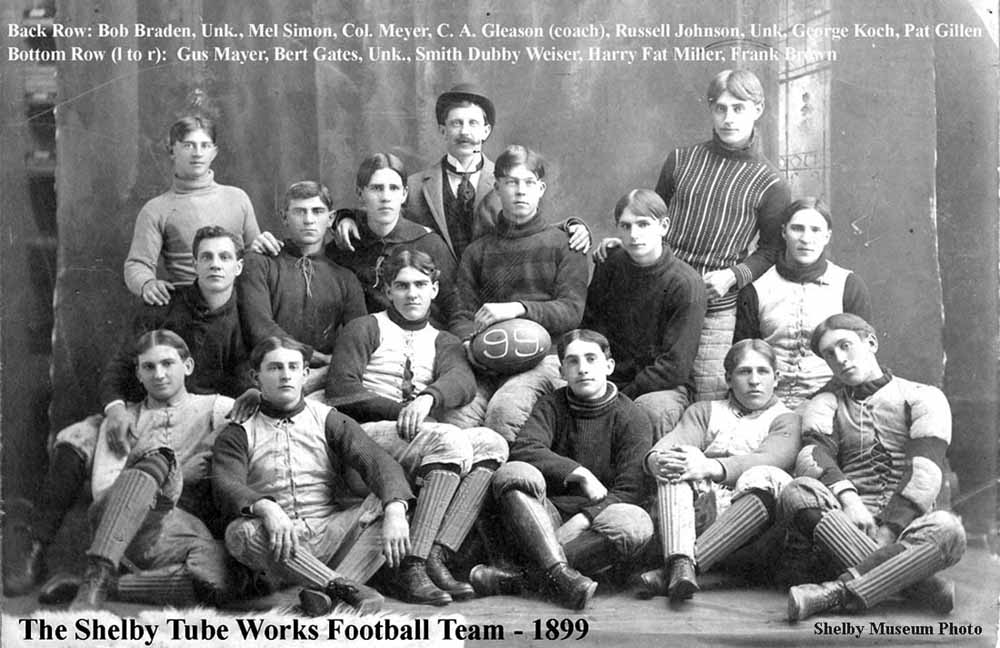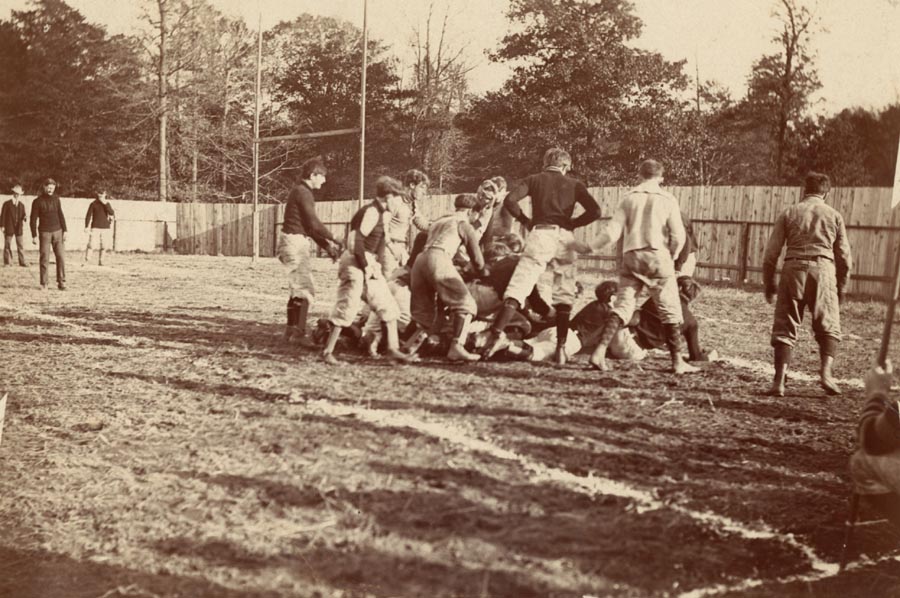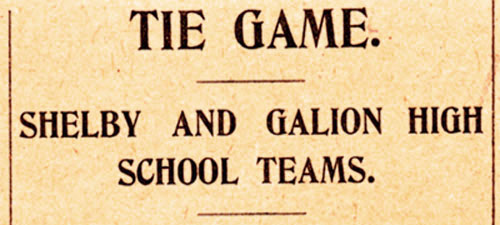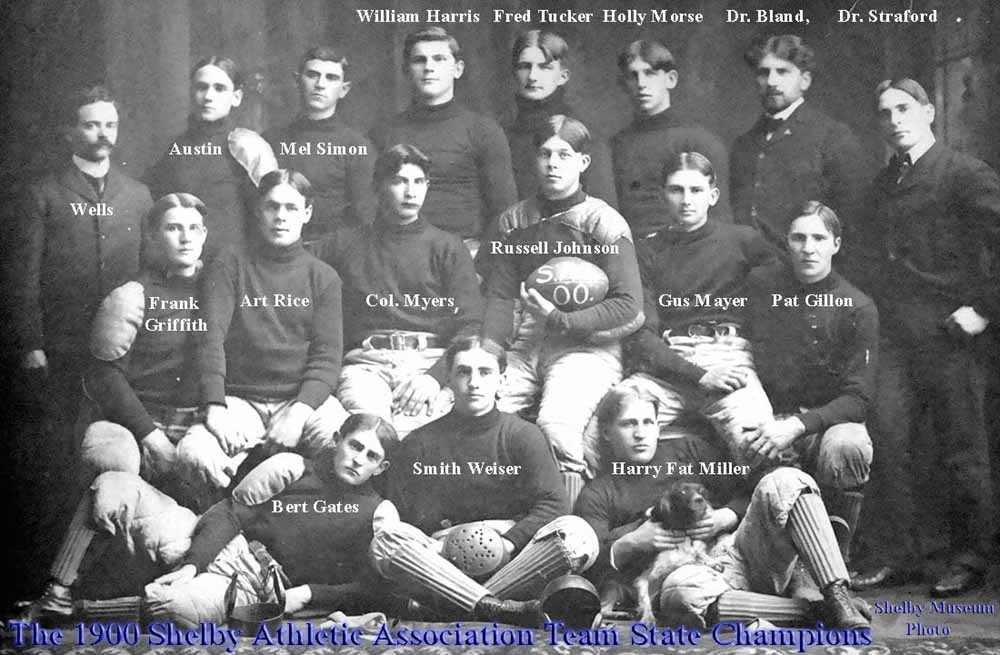- The
1899 Shelby Tube Works football team would this year have an
official coach and the team would re-elect Russell Johnson
as their team captain. This 1899 team was a transition team,
starting as another "Tube Works" team and concluded
the season as the "Shelby Athletic Club" team.
-
- The
coach pictured above with the 1899 players is C. A. Gleason.
The 1900-1901 Shelby directory records a C. A. Gleason living
at 23 Marvin Avenue and lists his occupation as Government inspector,
Tube Works. This must be the Tube Works team coach. (The 23 Marvin
Avenue residence was occupied by the A. W. Gump family in 1900.
The Gump family, after the closing of the Shelby Cycle Co., had
moved back to Dayton, Ohio by the time the 1900 - 1901 directory
was printed.) The Daily Globe newspaper edition of September
14, 1900 notes the approaching marriage of Mr. Charles A. Gleason
of this city to Miss Florence Jeanette Ford of Cleveland, Ohio.
Mr. Gleason is employed as a chemist at the Tube Works. The marriage
took place about two weeks later. The couple would have their
first child Elizabeth c. 1902. Coach Gleason would remain the
following two football seasons, in 1900 as a staff member and
in 1901 again as coach. The Gleason family was living in West
Hartford, Connecticut in 1910. Charles was an inspector of "Naval
materials".
-
- Bottom
row left is Gus Mayer, born Augustus J. Mayer in 1875,
a son of Joseph and Mary Cecilia Fisher Meyer. Joseph Meyer immigrated
from Germany in 1862 and was living in Sandusky, Ohio when he
married Mary Cecilia Fisher in 1868. Within five years Joseph
and Mary were living in Shelby and Joseph had a saloon on Main
Street. Joseph was to have many occupations during his lifetime,
saloon keeper, shoemaker, baker and steel mill laborer. In 1900
the now Mayer family was living at 75 West Main Street. The 1900-1901
Shelby Directory shows them living at 75 West Main Street and
Joseph employed as a baker.
-
- Gus
was the youngest of the Mayer sons who played on the early Shelby
pro teams. He had played previously on the 1896 and 1898 Shelby
Tube Works teams and would continue to play for several more
seasons. One difficulty in determining just who was playing and
when, is the problem of correct surname spelling. Newspapers
were not too accurate in their reporting of names and for that
reason, pictures (with names added later) and memorabilia are
many times mislabeled with names misspelled and misplaced. Gus's
surname is a prime example. He has been labeled: Meyer, Meyers,
Myer, Myers, Mayers, as well as the correct Mayer. In the 1899
season, Gus played at the half back (HB) position.
-
- Bert
Gates was
probably a son of Henry C. and Emma Eunice Bly Gates. In the
censuses, she was sometimes known as Arris and was also referred
to as Unice, probably named after Unice Hawkins, who was an earlier
wife of Henry Gates. Unice, born c. 1856, was one of the youngest
daughters of the Henry and Roanna Hannah Wolf Bly family who
moved to the Shenandoah, Ohio area from Shenandoah County, Virginia
in c.1852. Bert's father, Henry C. born c. 1854, was a son of
Martin and Frances Ergnehart Gates, who were married in 1843
in Richland County, Ohio. Henry and Unice were married in 1874
in Richland County, Ohio and started their family with Walter
born c. 1875 and then Bert born c. 1877 while living in the area
of Rome, Ohio. The family would grow to at least five children
with both parents dying at a young age - Henry at 33 and Unice
at 38. Their youngest son Boyden, sometimes Boyd, sometimes Burt,
is buried beside them in Oakland Cemetery. Burt was born four
years after Bert our subject football player (the reason for
the use of "probably" in the opening sentence). Bert
started playing football in 1896 with the first Shelby Tube Works
team and continued playing at least through the 1901 Shelby Athletic
Association Team season. In 1900 he was living at 149 West Main
Street with his sister Moleska and her husband Charles E. Miller.
Charles was a clerk in the Tube Mill office and Bert was a tube
straightener in the mill. The 1900 - 1901 Shelby directory shows
Bert Gates living at 84 Walnut Street along with several others.
Bert was still employed by the Tube Works. From here the story
gets more interesting. The 1906 Shelby directory lists Albert
Gates who works at Brightman Manf. living at 24 East Smiley Avenue
as well as Bert R. Gates who works at Brightman Manf. and Grace
I. Gates who works at Shelby Printing and Ina N. Gates who is
employed at the "Hinge".(Shelby Spring Hinge). One
may be our Bert, but Bert R. is probably Albert Ross Gates who
is brother to Grace Iva Gates and Ina Naomi Gates who appear
to be sharing the dwelling. The parents of this Gates family
are Albert L. and Martha Adams Gates. Albert L. Gates was born
in Paradise, Ashland Co., Ohio. This doesn't appear to be helpful
information unless it's understood to eliminate several Alberts
from our Bert Gates the football player mix. Maybe the 1908-1909
Shelby directory will help sort this out. Albert and Martha Gates
are living at 22 East Smiley Avenue as well as daughters Grace
and Ina and son now referred to as Ross. No mention of any other
Bert Gates.
-
- On-line
records might be helpful at this time. One on-line family tree
indicates that Bert C. Gates, bn c. 1877, is the son of Henry
and Eunice Bly Gates and married Nettie Jane Orr in 1904 in Wooster,
Ohio.
-
- Another
on-line service indicates that Bert C. Gates was the son of George
and Frella Kapp Gates of Medina Co., Ohio, and married Maude
A. Williams in Wellington, Ohio in early 1900. This is too early.
-
- Another
search finds Bert C. Gates bn March 1876 son of George and Ferlla
Kapp Gates of Medina Co., Ohio, married Nettie J. Orr in 1904
in Wayne, County, Ohio. This must the marriage used in the above
family tree, but it clearly states his parents are not Henry
and Unice Gates.
-
- Finally
a search reveals Bert Gates bn 1878 in Rhome, Ohio, son of Henry
and Eunice Bly Gates married Margaret McDonald in Mahoning Co.,
Ohio on May 3, 1905. This looks like the correct information.
It explains the absence of Bert Gates in the 1906 Shelby directory
and puts the search on the right track. Problems solved......
-
- The
1910 census finds Bert and Margaret McDonald Gates, married five
years, living in Ellwood City, Lawrence County, Pa. in Margaret's
widowed mother Jennie McDonald's boarding house. Bert is employed
as a tube straightener at a tube mill. In 1920, Margaret is still
living with her mother in the boarding house, but Bert is not.
Margaret lists herself as divorced. Another on-line document
indicates Bert Gates married Ethel Cooper, 24 (born in England)
in Lawrence County, Pennsylvania in 1915. The 1920 census finds
Bert and Ethel Gates living in Ellwood City, Pennsylvania and
Bert employed as a laborer in the steel mill. Living with them
is Walter Gates, brother, also employed in the steel mill. This
is strong proof of them being the two oldest sons of Henry and
Unice Gates of Rome, Ohio. In 1930 Bert and Ethel were still
living at Ellwood City and Bert was a foreman at the steel mill.
It appears that Bert died there in 1939 evidently childless..
-
- Next
player in the bottom row is Smith Weiser, sometimes called
Dubby, Dubbie or Dubie; the significance is unknown at this time.
He was born Smith Francis Weiser in 1880, most likely in Shelby,
Ohio. His parents were John William and Lucinda Kingsboro Weiser,
both Shelby area natives. Smith began playing football in 1896
with the Tube Works team and continued through 1905 and in doing
so, his career encompassed the Tube Works, Shelby Athletic Assoc.,
Shelby Athletic Club and Shelby Blues football team organizations.
There is no record of his playing high school football but he
was playing for the Tube Works at age 16. Smith often played
quarterback (QB) and did so in 1899. In 1900 Smith was living
at 26 S. Broadway in Shelby and was working as a laborer at the
Tube Works. The 1900-1901 Shelby directory yields the same information.
There is no record of his graduation from Shelby High School,
however the class of 1900 included Helen Knabenshue who in 1902
would marry Smith Weiser. Helen was one of three daughters of
Oscar D. and Katherine Sawyer Knabenshue. The family lived at
213 West Main Street and Oscar was a real estate agent. The 1906
Shelby directory shows the Weisers living at 76 N. Gamble Street
in Shelby. By 1910 Smith and Helen were living in Dayton and
Smith was employed as a toolmaker at National Cash Register Company.
1920 through 1940 censuses find them living in Detroit, Michigan
with Smith employed as a toolmaker. Helen's father and sister
Gertrude are living with them in 1940. There is no evidence that
Smith and Helen had children.
-
- Sitting
next to Smith is Harry Blaine "Fat" Miller,
who started playing on the 1896, 1897 Shelby High School teams
(See Part I). Harry would play end (E) on this 1899 team.
-
- On
the right side of the bottom row is Frank Brown, a charter
player from the 1894 Shelby High School football team. (See Part
I). Frank started in 1894 playing half back (HB) and continued
at that position on this 1899 Tube Team.
-
- On
the left in the top row is Bob Braden who was a son of
Era William and Jane Jennie Lowrie Braden. The family was living
on Broadway Street, Shelby when Robert Charles Braden was born
in 1879. Ezra was working in a lumber yard (Brucker Lumber?)
at the time. Jennie was born in Scotland and immigrated to this
country with her family in 1853 when she was three. She married
Ezra Braden in Richland County in 1873 and they started their
family a year later with the birth of their only daughter Nellie.
Bob Braden played football with the Shelby Tube team in 1899
as well as the Shelby High School football team. He played left
end (LE) for the high school team but it's not known what position
on the Tube team. It appears he only played football one season.
In 1900 he was living at 18 East Whitney Avenue and employed
as a horse shoer. By 1906 he was working as a barber and living
at 16 East Whitney Avenue. He would keep this occupation until
later in life he became employed by the City of Shelby. Robb
Braden died in 1937, single, living with his brother Herbert
and their family at 16 East Whitney Avenue. He is buried at Oakland
Cemetery.
-
- Third
player from the left is Melville Victor Simon born in
1870 to Victor E. and Margaret Melville Simon. Victor E. Simon
was a Civil War veteran who served in Co. I, 15th Regt. of the
Ohio Volunteer Infantry (OVI) and the oldest child of Theodore
and Mary Ann Ursula Cattey Simon. Mel's mother died in 1881 when
he was eleven and his father in 1889 in Williams County, Ohio.
The children (10) moved to Shelby and the older boys got jobs
at the Tube Works while the older sisters, Florence and Maude,
looked after the younger siblings at their home at 20 Sharon
Street. Melville married Catherine Ryan in 1906 in Wayne County,
Ohio. The 1908-1909 Shelby Directory shows Mel and Catherine
living at 17 Seltzer Avenue and he was blacksmithing. In 1910
the family was living at 23 Auburn Street and two children, Margaret
3, and William 2, have been added. Catherine died in 1913 leaving
behind the two young children. One of Melville's younger brothers,
Albert Charles Simon died in 1916 leaving a widow with four young
children. Shortly thereafter, Melville married Anna Rachel Mackey
Simon (Albert's widow) and they began to raise their combined
families. The 1930 census finds Melville and Anna living in Florence,
Burlington County, New Jersey. Melville is a wire worker in a
steel mill. Their 1930 family consists of Ellen and Bill (children
from Mel's first marriage), Walter, Charles, Mary and Doris (Albert
and Anna's children) and Joseph, Robert and Raymond (Mel and
Anna's children). Melville died in 1936 in a hunting accident
leaving the family to Anna. By 1940 Anna was living at 70 1/2
West Main Street in Shelby, Ohio with two of her sons and a sister.
-
- Mel
Simon played tackle (T) for the 1899 Tube Works football team
and continued playing for the Shelby Athletic Association teams
in 1900 until his leg was broken in the first game against Wooster
in 1901. It was such a bad break that it was determined that
he would play no more football.
-
- The
next person to the right in the back row is labeled "Col.
Meyer". This is Cornelius J. (sometimes "Dutch")
Mayer, a brother of Gus Mayer (front row). He was born in 1881
in Shelby and this was perhaps his first year playing Shelby
football. He would play for the various Shelby professional football
teams for another ten years often at the full back (FB) position.
Much will be heard from him in the future.
-
- Russell
Johnson
was briefly introduced in part I. He was the oldest son of Daniel
and Elizabeth Whitney Johnston, born in 1880 in New Washington,
Ohio. By 1900 he and his parents were living at 54 North Broadway
in Shelby and Russell was employed at the Tube Works. Russell
started playing football with the 1896 and 1897 Shelby High School
teams and in 1899 was a major contributor to the Shelby Tube
Works team. He played the center (C) position and was many times
elected team captain as was the case in 1899. Russell married
Bessie Mabel Kern, a daughter of Thomas and Anna Palm Kern, late
in 1905. They were living at 64 East Whitney Avenue in 1906 and
in 1910 had moved to 82 Whitney Avenue and were the parents of
Lowell K. Johnston, age 3. Russell, Bessie and Lowell moved to
Ashland, Ohio by 1930 and Russell was a dealer in the ice business.
He died at an early age in 1932, Bessie in 1971 and Lowell in
1973. All are buried at the Ashland Cemetery.
-
- George
Peter Koch
was discussed in part I, which leaves the final person on the
right of the top row - Patrick Joseph Gillen. Pat's ties
to Shelby are only slight. He was born c 1879 in Warren, Trumbull
County, Ohio. His parents were James and Jane Dale Gillen, both
born in Ireland and immigrating to the US in 1872. There has
been no Shelby directory that records the presence of Patrick
Gillen, however, Richland County Court records show that in April
of 1900, Patrick Gillen married Catherine Elizabeth Hollenbaugh.
"Lizzie" was born in 1880, a daughter of David and
Elizabeth Hannah Rowe Hollenbaugh. There is also a record of
a "baby" Gillen buried in the Oakland Cemetery that
is noted as "the baby of P. F. Gillen". The baby is
buried in the David and Elizabeth H. Hollenbaugh section. The
1900 census (taken June 2, 1900) indicates that Patrick and Lizzie
Gillen are living in Warren, Ohio with James and Jane Gillen.
Patrick is employed as an electrician. In 1910 the family is
living in Warren, Ohio and they have an addition of A. Harold
Gillen age 7 as well as William Hollenbaugh age 19 (nephew in
law). Patrick is now a shipping clerk for a fire extinguisher
company. Patrick had become a Warren County detective by the
time of the 1920 census. Patrick died in Warren County, Ohio
in 1925 and Lizzie in 1943. They as well as Harold Gillen are
buried in the Oakwood Cemetery in Warren, Ohio.
|











